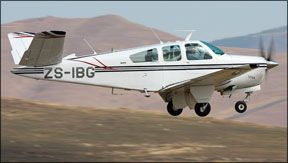If Piper put general aviation on the map with the J-3 Cub, Beechcraft made it possible to actually go places on that map, thanks to the incomparable Bonanza. With antecedents dating to 1947, the venerable V-tail remained in continuous production until 1982, something no other model can claim. Photo by Gary Shephard The Bonanzas unique combination of good looks, cabin comfort, high performance and good load carrying capability earned it a loyal following that continues yet today. Indeed, some owners say the early models are among the best values on the used aircraft market, but we urge a dollop of caution. Unless those 50- and 60-year-old airframes have been we’ll maintained, they can be, in the words of one owner, a money pit. But the good news is that there are plenty of “modern” Bonanzas to pick from and owners are rabidly loyal to these airplanes. Although not cheap to operate, they arent unreasonable, either. Parts and support remain easily available, although owners concede parts can be expensive. The V-tails suffered a bad rep thanks to a series of breakups during the 1980s, but these airplanes have been subjected to a Beech-developed tail beef-up kit that has all but eliminated the breakup issue. 
Model History
The first V-tail Bonanzas were so ingeniously conceived that it appears they sprang from the mind of designer Ralph Harmon and others full-blown in the dim past of 1945. At the outset, the airplane was like nothing else on the market: fast and slick and great looking. The basic format was retained for decades through fine-tuning, strengthening and bigger engine iterations, yielding a plethora of model designations.
In keeping with Beechcrafts reputation for excellence, the early Bos got the benefit of wind tunnel testing and study to find ways to boost speed and increase safety, something not commonly done in the 1940s. This shows in the details, such as fully retractable tricycle gear, with no projecting bumps or humps as on some other aircraft and extensive use of flush-riveting. A unique fuselage design incorporates a sled-like keel arrangement and box structure to increase crashworthiness. This structure extends into the engine compartment, with the motor mounted on keel extensions, making it easy to access for most maintenance operations. Huge side windows were hinged at the top with quick release openings at the bottom to allow easy escape in an emergency, a side benefit that was blessed forever afterward by rear-seat passengers.
Straight 35
The first so-called “straight 35” model Bonanza had a 165-HP Continental engine that produced an amazing 175 MPH at cruise speed. These models are among the cheapest Bonanzas on the market these days, but we would counsel potential buyers to be cautious. Unlike later models, the straight 35 lacks a shear web in
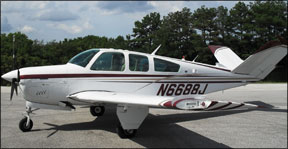
the main wing spar-a design strategy undertaken to save weight. And although Beech offered a “35R” wing strengthening conversion in 1951, there werent many takers for the expensive mod (then $6000, compared to the cost of a new C35 of only $12,990). Beech offered a number of wing mods and there was an after-market mod called the Jourdan-Flannagan mod.
We advise avoiding these but if youre considering one, the American Bonanza Society believes they can be operated safely if you do your homework. That means a careful pre-buy inspection and a checkout that emphasizes operating limitations.
With the succeeding A35, Beech made important strengthening improvements, added a new wing carrythrough structure and thicker wing skins and fuselage stringers. They beefed up the fuselage bulkhead at the tail attachment. On the B35, a slight power boost during takeoff of 11 HP was engineered through slightly higher RPM.
With the C35, major changes were made to the stabilizer. The chord was increased by 14.4 percent and the dihedral increased slightly in an attempt to reduce yawing. The chord increase was made by simply extending the leading edge, but leaving the front spar where it was.
This created a greater overhang forward of the spar that would figure in tail-twisting during in-flight breakups and would later be secured by a bracket after a big FAA/Beech investigation into the breakup problem.
With the E35, buyers had the option of a 225-HP Continental engine. Also, aileron trim was added for the first time and back-seat passengers got a couple inches more leg room. The magnesium flaps were replaced with aluminum ones. In the G35, the wing was beefed up once again. And gear extension speed went up from 125 to 140 MPH, the first in a series of speed boosts that would make the landing gear an effective speed brake.
Modern Bonanzas
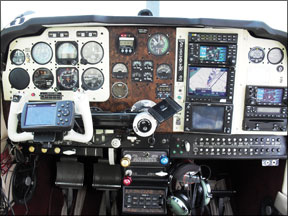
The H-model represents what Larry Ball in his book, The Incomparable Bonanzas, calls the beginning of a second generation of Bonanzas. The airplane got a bigger 240-HP powerplant which, for the first time in the line, offered identical takeoff and max continuous horsepower. This was the first wet sump design for the Bonanzas, allowing oil to be carried internally rather than in a separate oil tank, thus simplifying the plumbing somewhat. Additional strengthening was also added to tail, fuselage and wings.
The major change on the J35 was a switch to a 250-HP fuel-injected engine. On the K35, the standard fuel capacity was boosted from 40 to 50 gallons, which with the 20-gallon aux tanks gave 70 gallons and moved the airplane up into the serious cross country machine it is today. Also, an optional fifth jump seat was offered, allowing more chances to load aft of the weight-and-balance envelope. Throw it away is our advice and many owners seem to agree.
Elongated, curved rear side windows were added to the N35. Horsepower went up to 260 and fuel capacity rose to 80 gallons, while the number of fuel tanks was reduced to two. This was done by offering optional 40-gallon tanks in place of the standard 25-gallon tanks. Along with “full time” fuel quantity gauges provided to both tanks, fuel management was simplified, a good safety feature.
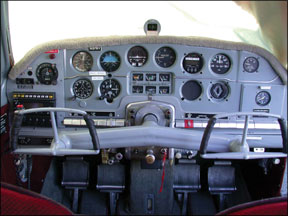
The addition of new, long leading edge fuel tanks displaced wing landing lights, which in turn were moved to the nose and nose gear strut, where they remain in modern designs. Landing light bulb replacement is thus among the easiest of all GA models. Pilots concerned with tracking troublesome magnesium components might also note the ailerons were converted to aluminum, thus easing repairs and repainting somewhat.
On the used market, the P35 is one of the best values, perhaps because it got a completely redesigned instrument panel, with the famous “piano keyboard” switch arrangement of the early models abandoned in favor of conventional switches, albeit not always located in the best places along the lower panel eyebrow. The P-model saw a higher landing gear extension speed, up from 140 to 165 MPH. Although the P-model was a large step forward, Beech had even bigger ideas.
The S35 Bonanza got a 285-HP powerplant and a longer cabin with a new aft window shape like that found on Barons. The aft bulkhead was moved back 19 inches and although this made for a comfy cabin, it planted the seed of what has become a chronic complaint among Bonanza owners: aft CG. To address that in the S-model, Beech added a 25-pound lead weight to the nose for balance.
Theoretically, the S-model was a six seater. But not really. Its just not practical to stuff passengers back there, unless theyre lightweight kids. The larger baggage compartment door is a nice plus, however. Visibility out front improved with the V35 model as a one-piece windshield was made standard. And on the V35A that followed, a bigger, swept windshield was added that allowed more space behind the instrument panel for maintenance.
A V35TC turbocharged model was added to the line for the first time, also. Normal gear-down speed went from 165 to 175 MPH. The big safety improvement on the V35Bs was tgw addition of anti-slosh fuel cells to prevent inadvertent unporting during slips, skids and turning takeoffs, a shortcoming that had caused mishaps. Some models carry placards advising of minimum takeoff fuel, but many have anti-slosh baffles to address this.
Performance
Bonanzas are famous for their speed and justifiably so. With the largish engines and relatively low drag, owners report cruise in the 150- to 175-knot range, depending on engine power. The real eye opener with regard to raw speed is the conversion to an IO-550, which a number of owners have done.
That speed comes at a price, however. Like Mooneys and other high-performance airplanes, the Bonanza is slick and will build speed quickly in a dive or an upset, thus it requires attention from the pilot in instrument conditions or potentially moderate turbulence. Bo pilots are wisely taught the desperation tactic of lowering the gear to arrest an out-of-control dive or unusual attitude.
Anyone who has stepped into a Bonanza from another model is immediately impressed with how we’ll the V-tail (and straight-tails) handle. The controls are silky smooth and light with nearly perfect harmony between aileron and pitch pressure. However, the stick-forces-per-G are also light, which means that the ham-fisted pilot has less margin in turbulent air. Even with the tail mods, the airframe can still be bent.
As with any high-performance airplanes, landings require good speed control. Although they can be done power off, most pilots seem to fly the approach with just a bit of throttle to improve ruddervator response and avoid sink fests.
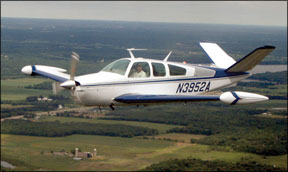
Consistent, smooth touchdowns are achievable but, more to the point, really screwing up a landing in a Bonanza is hard to do. It doesnt have the Mooneys vicious porpoise or the Saratogas tendency to plop.
What it does have is the famous Bonanza tail waggle in turbulence, which is bound to make backseaters with tender stomachs somewhat queasy. Oddly, many believe the tail waggle is unique to the V-tail, but the straight-tail 33s have it too. Some owners ignore it; some say a yaw damper is required equipment.
Weight and Balance
Apart from the tail waggle, passengers give Bonanzas high marks. For one thing, there’s plenty of shoulder and head room; the interior feels more like a 1950s Chevy than the cramped interior of the typical high-performance single. The front seats are relatively upright and comfortable, but lack much forward and rearward adjustment. Leg room is adequate in both front and rear seats. By GA standards, the giant windows give unmatched airiness and visibility, especially out the rear side windows and forward through the windshield.
When carrying passengers, Bonanza pilots learn to brief them carefully on closing the cabin door. Most pilots do it themselves, for if not properly secured, the door is almost certain to pop open on rotation. Its not an aerodynamic hazard to further flight ,but can be dangerously distracting.
The aircrafts loading Achilles heel is its relatively narrow weight-and-balance envelope, a peccadillo owners bitch about. Even without big-butted passengers, its easy to load aft of the rear CG, a potentially nasty situation in any airplane, but doubly so in one with controls as light as those on the Bonanza.
And on later models, as fuel burns out of the leading edge wing tanks, the center of gravity shifts farther to the rear, aggravating the situation. V-tail Bonanzas have generally stricter rear CG limits than the straight-tail models, which means that the same load will put you a lot closer to the aft limit in a V-tail.
Maintenance
Buyers should be alert to three main problem areas: Damaged control cables, rods, fittings, malfunctioning, out-of-order landing gear components and corrosion. The landing gear and corrosion problems can be especially expensive to repair. There were also quite a few reports of corrosion in the aft fuselage section-many uncovered during the thorough inspection required by Beech Aircraft Corp. as part of the tail-brace installation. Obviously, the tail fix will have been completed more than 20 years ago, but that doesnt mean corrosion will stop. The airplane should be inspected carefully.
Proper ruddervator balance has always been a critical matter on the V-tail Bonanzas to prevent flutter or vibration, which can contribute to severe structural damage and even inflight break-ups. We found at least four of these incidents in our recent scan of accidents. The balance margin is so narrow that unbalance could-and has-resulted from repainting the ruddervators without rebalancing afterwards. Most shops know all about this but some still make the error anyway.
Corrosion is often encountered with magnesium components like the ruddervators and on some Bonanzas, the flaps and ailerons. But check other components as well, as the Bonanza fleet ages. Some corrosion may have been we’ll hidden. The 35 series is not exactly slammed with ADs, but a prospective buyer should check the list carefully, especially the tail fix AD.
Mods, Owner Group
A lot of mods are available for Bonanzas, from STOL kits (Sierra, www.sijet.com) to engine swaps (DShannon Aviations IO-550, www.beryldshannon.com), to speed brakes (Precise Flight, www.preciseflight.com) to TKS anti-ice systems from CAV Aerospace at www.weepingwings.com.
DShannon also offers vortex generators, which are a worthwhile investment. Speaking of things worthy, The American Bonanza Society (www.bonanza.org)
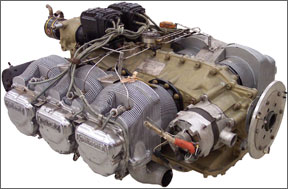
provides a good-looking four-color magazine, plus lots of technical advice. It sponsors pilot training and maintenance clinics around the country through its affiliated Bonanza Pilot Proficiency Program.
We would consider membership in this group a must for Bo owners, but especially any owner new to the airplane. Contact The American Bonanza Society, P.O. Box 12888, Wichita, KS 67277, 316-945-1700 or www.bonanza.org.
Owner Feedback
I purchased a 1979 V35B in 2007. She has been a wonderful airplane to fly and extremely reliable. If you are thinking about stepping up to a Bonanza or any other high-performance aircraft, make sure you are ready to make the jump. The Bonanza is an aircraft that you have to stay in front of and one that is less forgiving than the Warrior/Skyhawk herd.
The airplane carries 80 gallons (72 useable) and you can count on burning 15 gallons per hour rich of peak. ROP operations will typically allow me around 4.5 hours of flight time; lean-of-peak operations can push this to 5-plus hours. The airplane climbs with one on board at 1500 FPM to about 3000 feet and then about 1200 FPM to about 6000 feet. At cruise altitude, you can count on truing at 171 knots on 14.5 to 15 GPH, rich of peak.
The aircraft is a solid IFR platform and has yet to disappoint. The addition of Garmin GNS430Ws and the MX20 Chart View coupled to the autopilot have greatly reduced workload and allows me to concentrate on cockpit management rather than focusing on a set of gauges.
The Bonanza is a slippery aircraft and once you point the nose down, it tends to easily accelerate into the yellow arc. When I first started approaches, I typically flew them at 70 to 80 knots. I will approach closer to 120 knots now, as I have grown more comfortable with the speed of the aircraft, slowing for a touchdown at 70 to 80 knots. The Bonanza seems to handle crosswind landings with little struggle.
The operating costs for the aircraft are not out of this world. The insurance my first year was a bit high at $3200, but has since come down to $2200. The annuals average about $3000. One thing about the Bonanza that I noticed, and maybe it is true for all Beechcraft, is that they don’t break often but when they do, prepare to write the check.
Useful load is about 1100 pounds; with tip tanks, this increases another 100 pounds. I currently have an IO-520-BB and I have given thought to a 310-HP IO-550. The V-series has been plagued with a CG issue which cannot be ignored. You must be mindful of how you load the aircraft as the CG shifts to the aft in flight as fuel is burned. Be careful how many of those large suitcases you stuff back there.
Overall, the V-tail is a quality aircraft and a solid IFR platform. I would highly recommend it.
Todd Quesnel
Houston, Texas
I have owned a 1967 V35 since June, 2006. I have added 425.7 hours to the tach since that time. About a year before I purchased “Alphaba” (after my favorite “Wicked” character, “Elphaba”), the local FBO had completely rebuilt the airplane for another customer, adding a zero-time IO-550, Hartzell Scimitar prop, backup alternator, Beryl DShannon tip tanks, a Garmin GNS530 with XM weather and traffic, S-TEC 55, Sandel 3308 and a new paint job.
My airplane will fly at a top speed of 177 knots burning about 17.5 gallons per hour with wide-open throttle. Since thats obviously not a cruise configuration, I set high-speed cruise at 75 percent power to run 169 knots at 16 GPH or 65 percent power for 157 knots and 13 GPH.
I have loved the way V-tail Bonanzas looked since I was 10 years old and saw the first one of them at Dress Regional Airport in Evansville, Indiana. Since obtaining my license in 1973, I had hoped some day to own one. My favorite things about this particular model include the wonderful Garmin GNS530 set-up, the outstanding autopilot and the tip tanks. Although I havent needed it in IFR, the back-up
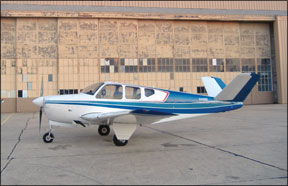
alternator provides reassurance, too.
My Bonanza carries full fuel and four passengers or three 190-pound men with golf clubs and luggage with no problem. The extended range tanks have let me easily fly five-hour legs from St. Petersburg, Florida to Columbus, Ohio, or from Bangor, Maine, to Columbus with adverse winds.
The only major unplanned expense I have seen was the $8000 tab to re-skin the magnesium V-tail surfaces, due to a bit of pitting. Otherwise the airplane has been quite solid and reliable and a pride to own.
Ken Deken
Willoughby, Ohio
Ive owned a 1979 V35B since 1992 and have flown it nearly 2500 hours throughout the U. S., Canada and the Bahamas. My Bonanzas capabilities, in terms of comfort, handling and mission, exceeded my expectations.
Prior to owning the Bonanza, I flew a Mooney as part of a club. In my opinion, the Bonanza exceeds the Mooney in comfort and performance, as we’ll as value when considering the resale and operating cost of comparable model years. I did look at upgrading to a Baron at one point, but after my mechanic showed the maintenance bills of a friends 1979 BE55, it was clear that cost of operation would triple for the sake of a few knots. I decided to pass on the Baron.
Mods include the Mike Smith gap seals, yaw skeg and tail bulkhead plus DShannon IO-550B and baffles with GAMIjectors. Rich of peak, I true at 180 knots with a fuel burn of 17 to 18 GPH. While lean of peak, I typically see 172 knots at 12 to 13 GPH. On an IFR trip last February from Sarasota, Florida, to Suffolk, Virginia, we departed just ahead of a SR22. While we both chose the same altitude, there were never any ATC spacing issues with the SR22 in trail. After landing, it was interesting to see that I needed 50 gallons to his 60 gallons.
Operating costs average about $15,000 per year and based on an average of 100 hours a year, flying it rounds out to about $170 an hour. Annuals have averaged about $2700 for the past three years and insurance at $2500 for $2 million smooth and $150,000 hull value.
Joe Palazzi
Wallingford, Connecticut
We have owned our 1956 G35 Bonanza since 2008. Prospective buyers must first realize the first Model 35 Bonanza is a much different aircraft than the last V-tail that rolled off the assembly line in 1982.
From the first Model 35 through the 1956 G35, the airplanes were powered by the Continental E-series engines. While these engines require special care and knowledge to operate, they are capable machines once the idiosyncrasies are mastered.
The E-series-powered aircraft originally came with the Beech Model 215 electric propeller. While some owners have had great luck with this system, the majority of the aircraft have been converted to a Hartzell constant-speed propeller, which has an AD inspection required every five years if equipped with the MV clamps (most are). The cost of this inspection is similar to an overhaul and we consider it a fixed cost. Not only does the Hartzell propeller require the inspection, but the associated external plumbing and parts make the engine compartment quite tight to work on with regards to the rear-mounted accessories.
The initial purchase price of these E-series aircraft can be comparable to aircraft with substantially smaller cabins and less performance and usually range from $40,000 to $60,000. Annual inspection costs range from $1000 to $1800 a year when no major discrepancies are found.
After our airplane was purchased, it immediately required overhauls of almost every accessory due to the age and disuse. We found that once we started to replace one item, the next thing needed to be replaced and so on until we had a failure of the T-drive, which powers the fuel pump and prop governor.
This caused metal parts to find their way into the engine and a teardown had to be conducted. Overhauls of the E-series engines can be expensive, with parts and knowledgeable mechanics hard to find, although they are still readily available.
Now that we have repaired our aircraft and made it reliable, it is truly a great cross country machine. We consistently see TAS between 140 and 150 knots with a fuel burn of only 10 GPH. The wing seems happiest between 8000 and 10,000 feet in cruise, although with the lower horsepower engines, climb rates suffer compared to the higher horsepowered brethren.
Useful load is just under 900 pounds and with full fuel (53 gallons), we can still hoist just shy of 600 pounds. Loading flexibility is afforded with the auxiliary fuel tanks available in some variants of the E-series aircraft, which hold 19 gallons of useable fuel.
For those owners who want to get a lot of aircraft for the money, this aircraft is it. Its cabin dwarfs anything with a comparable cost and its passenger comfort is second to none in its class. With the engine turning at 2300 RPM in cruise, the cabin is reasonably quiet and we’ll ventilated and the aircraft exhibits true Beech quality.
As with any aircraft, a thorough pre-buy, information from the American Bonanza Society and a general knowledge of what you are getting is a must, because a poorly maintained example of this aircraft can be a money pit. Once you find a well-maintained aircraft, however, it will treat you we’ll and really take you places on a budget.
Zac Armstrong
New Braunfels, Texas
I flew my first Bonanza 35 in 1971 when I returned from Vietnam. I was an Air Force pilot and my dad had a 1950 B-35 that he used in his business. It had the upgraded E-225 engine (225 HP), electric prop, Osborne tanks and a 10-gallon aux tank for a total fuel load of 90 gallons. It cruised between 140 and 150 knots on 8 GPH. It was a pleasure to fly, very light on the controls and balanced, but the bench seat did not move fore and aft so I was a little cramped.
In 2002, I bought my own 1950 B-35 Bonanza, which was the last B model produced and was the last of the short-chord 35s. It also had the E-225 engine and electric prop and M-35 wing tips. The 35B is comfortable for four adults and small bags for three- or four-hour flights.
I decided to look for a newer 35 and found a 1970 V35B in Tucson with everything I was looking for and purchased it in 2004.
The V35B is an excellent cross country aircraft, especially with the tip tanks that add an additional 200 pounds to the maximum gross weight (3400 to 3600 pounds) so they essentially carry their own weight in fuel.
I run the engine lean of peak, which gives me 12 gallons per hour at 156 to 160 knots. The longest leg Ive flown her was 7.2 hours non-stop IFR, but the average leg is 4.5 hours. The versatility of the 35 is that it can be used as a high-speed cross country cruiser, or power back to 7 or 8 gallons for the pancake breakfast run or local sightseeing flight.
I compute about $140 to $150 per hour to operate the airplane, which includes fuel, maintenance, insurance and P & I on the remaining loan. Annual inspection runs between $1500 to $2500, depending on which parts need replacement.
Marty Noonan
Amery, Wisconsin

